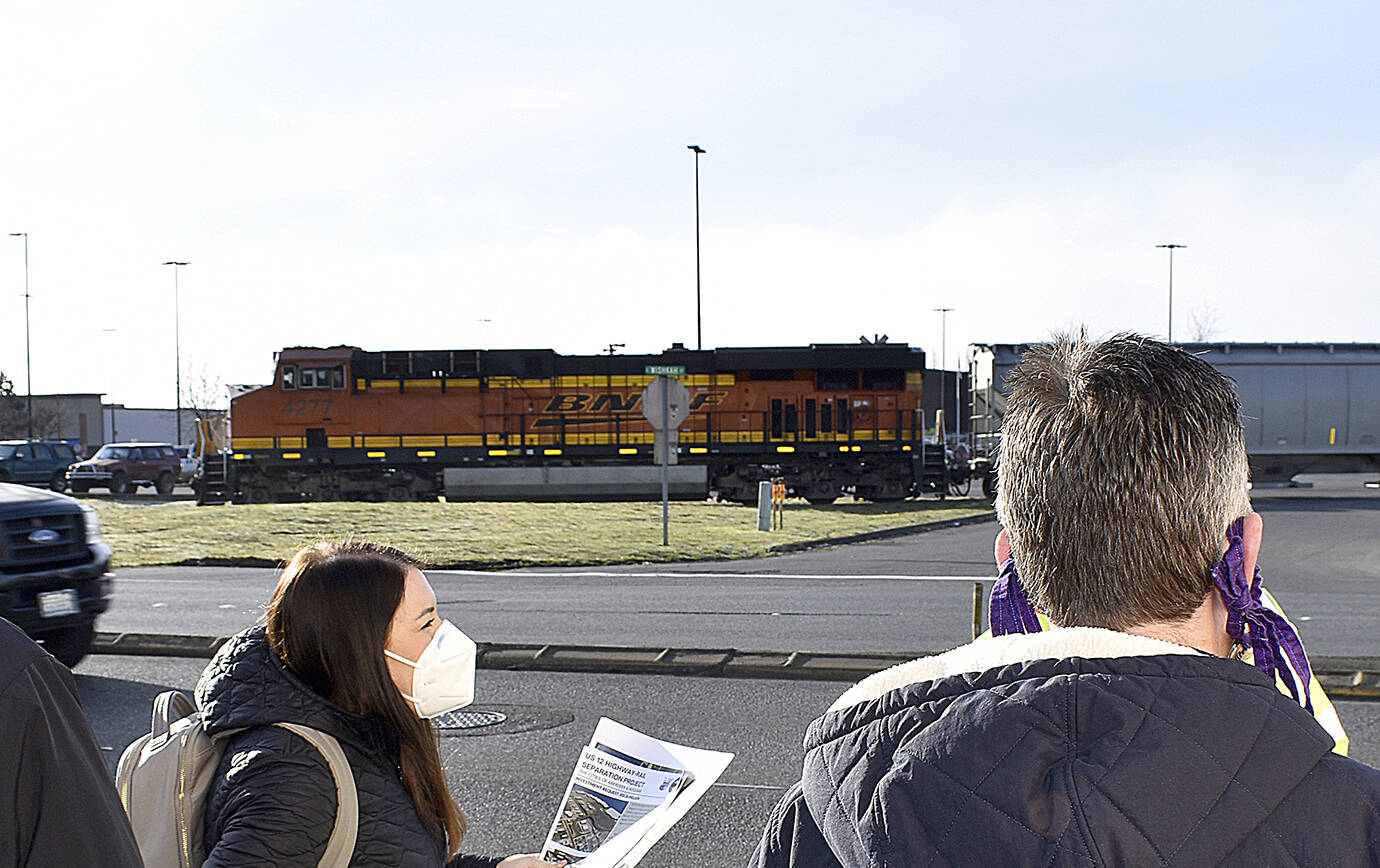Story updated Nov. 18
A $2.08 million federal grant will pay for pre-design work on the US 12 rail separation project in East Aberdeen, officials said.
The grant is part of $60 million in new federal awards for four transportation infrastructure projects in Western Washington that will help reduce traffic congestion, ease supply chain bottlenecks, create jobs, and boost local economies. Senators Patty Murray, D-Wash., and Maria Cantwell, D-Wash., made the announcement about the projects earlier this week.
The US 12 rail separation project in East Aberdeen is a large-scale project that would route vehicle traffic over and around the Port-bound train traffic that can cause major traffic snarls in the city’s largest commercial district.
“All of our federal representatives have made direct requests on our behalf to advance this project through Congress and the Department of Transportation’s grant process, and I am grateful for their partnership and support,” said Aberdeen Mayor Pete Schave. “This investment will produce real results through this pivotal freight corridor, not only for the City of Aberdeen, but across our region’s economy.”
Hoquiam Mayor Ben Winkelman thanked the region’s federal delegation as well.
“The project will greatly improve the US 12 freight corridor by developing our rail infrastructure to provide for lasting growth into the future,” he said. “Freight mobility is central to advancing our economy and sustaining efficient rail movement between the Port and our city.
Murray also touted the project’s potential positive impact on the Port of Grays Harbor, a major economic driver in the county.
“The federal support for this project will mean safer streets and less traffic for the people of Aberdeen. Removing these highway-rail crossings will also help move goods more quickly in and out of the Port of Grays Harbor, supporting the local economy and bolstering our supply chains,” said Murray.
The awards were made through the U.S. Department of Transportation’s Rebuilding America’s Infrastructure with Sustainability and Equity (RAISE) grant program. This is the first time four RAISE grants have been awarded at once to Washington state, which also received the second most funding of any state in the nation.
“This grant will help eliminate three highway-rail grade crossings along a critical stretch of Highway 12 in downtown Aberdeen that cut the community in half. It will improve safety and reduce congestion for freight bound for the Port of Grays Harbor,” said Cantwell.
“With each train blocking access to Olympic Gateway Plaza for up to half an hour, this project is sorely needed to reduce delays and ensure emergency vehicles can access the area.”
Murray originally created the RAISE program — previously known as TIGER and BUILD — in 2009 and has been a longtime supporter of the program, most recently helping secure $7.5 billion for the RAISE program — a 50% annual increase — in the Infrastructure Investment and Jobs Act, signed into law Monday by President Biden. The program is funded specifically via the Transportation, Housing and Urban Development, and Related Agencies Appropriations Subcommittee, of which Senator Murray is a member.
“I created the RAISE program to help make infrastructure projects like (the Aberdeen rail separation project) a reality, and as a senior member of the Senate Appropriations Committee, I’m going to keep working to get Washington state the federal infrastructure support it needs,” said Murray.
The grant will allow the city of Aberdeen to complete the planning phase of the project.
Currently, the roadway carries 28,000 vehicles per day, and trains can block the seven at-grade crossings in the corridor for up to 30 minutes per train. The rail crossings also delay truck traffic to the Port of Grays Harbor, which supports approximately 1,500 jobs.
With completion of the planning phase, the city will be eligible to apply for Cantwell’s new $3 billion highway-rail crossing elimination grant process to complete construction of the project.
The award comes following both senators sending a letter of support for the project to Secretary of Transportation Pete Buttigieg in July.
Congressman Derek Kilmer officially requested funding for this project through the House Surface Transportation Reauthorization bill, and also sent a letter of support for the project to Secretary of Transportation Pete Buttigieg.
“Folks who live in or have visited Aberdeen know all too well what it’s like to be stuck in traffic as a train rolls through town. Unfortunately, the lack of rail separation has created congestion, restricted emergency access to the region’s primary commercial area, and exacerbated safety concerns,” said Kilmer. “I’m thrilled that the city has been awarded this RAISE grant from the Department of Transportation and will keep pushing to secure federal funding that will help Grays Harbor County rebuild essential infrastructure, reduce congestion, and revitalize local economies.”
Other recipients of RAISE grants include:
East Marginal Way Corridor Improvement Project, Seattle, $20 million.
“The federal dollars going towards the East Marginal Way Corridor Improvement Project will help get freight from the Port of Seattle to where it needs to go faster and reduce congestion in and around Seattle,” said Murray.
Industrial Rail Corridor Expansion, Port of Longview, $16 million.
“The federal funding for the Industrial Rail Corridor Expansion is going to mean goods flowing quickly in and out of the Port of Longview,” said Murray.
Granite Falls Bridge #102, Snohomish County, $22.1 million.
“The federal dollars to help build this new bridge will help critical supplies get to where they need to go like — timber and gravel — and reduce traffic,” said Murray. “This bridge will expand access for rural communities to centers of employment and it will expand recreational access for tourists and residents alike.”


